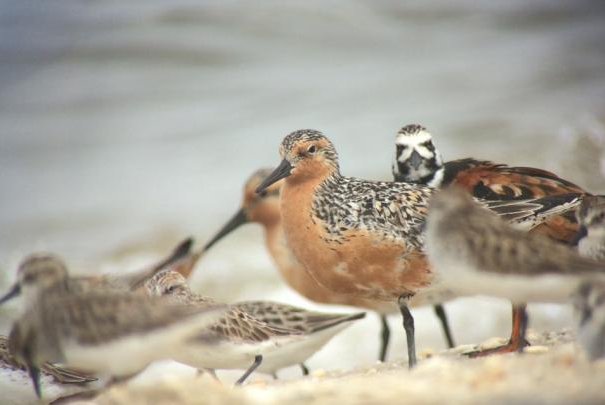Every year, red knots stop off along the Delaware Bayshore on the way from Chile to the Canadian Arctic. Photo by Brian Schumm
May 14 (UPI) -- New research suggests oyster farming can safely coexist with four vulnerable shorebirds found along the Delaware Bayshore, including the federally threatened red knot.
Every summer, red knots fly thousands of miles from Chile to their breeding grounds in the Arctic. Along the way, the birds stop on the Delaware coastline to feast on the eggs of horseshoe crabs.
Conservationists have expressed concerns that oyster aquaculture industry development could make the Delaware Bayshore a less inviting place for shorebirds, including the red knot.
For the new study -- published this week in the journal Ecosphere -- scientists analyzed the effects of oyster farming on the presence and behavior of four shorebird species: the red knot, ruddy turnstone, sanderling and semipalmated sandpiper.
The research team determined active tending of artificial oyster beds decreased the presence of shorebirds by 1 to 7 percent. Untended aquaculture infrastructure had no impact on bird presence. Researchers also found no discernible impact on the foraging rates or behavior of the four shorebird species.
Though still only a small presence among the intertidal flats of Delaware Bay, oyster farming has become increasingly popular in recent years.
"Oyster farming has many ecological benefits and is widely recognized as one of the most ecologically sustainable forms of food production," study co-author David Bushek, a professor and director of Rutger University's Haskin Shellfish Research Laboratory, said in a news release. "Farmers appreciate the ecology around them as they depend on it to produce their crop."
"The idea that oyster farming might be negatively impacting a threatened species concerns them deeply, so they've voluntarily taken on many precautionary measures," Bushek said. "They'd like to know which of these measures help and which don't as they all inhibit their ability to operate efficiently."
Balancing the needs of the local economy and those of important and vulnerable species can be difficult, but the latest research suggests there's reason to be optimistic about the relationship between oyster farming industry leaders and red knot conservation groups.
"Our research team represents a solid collaboration between aquaculture research scientists and conservation biologists, and we've produced scientifically robust and defensible results that will directly inform management of intertidal oysterculture along Delaware Bay and beyond," said lead study author Brooke Maslo, an assistant professor ecology, evolution and natural resources at Rutgers.
In future studies, scientists plan to study the effects of oyster aquaculture horseshoe crab eggs and other resources vital to migratory birds.















